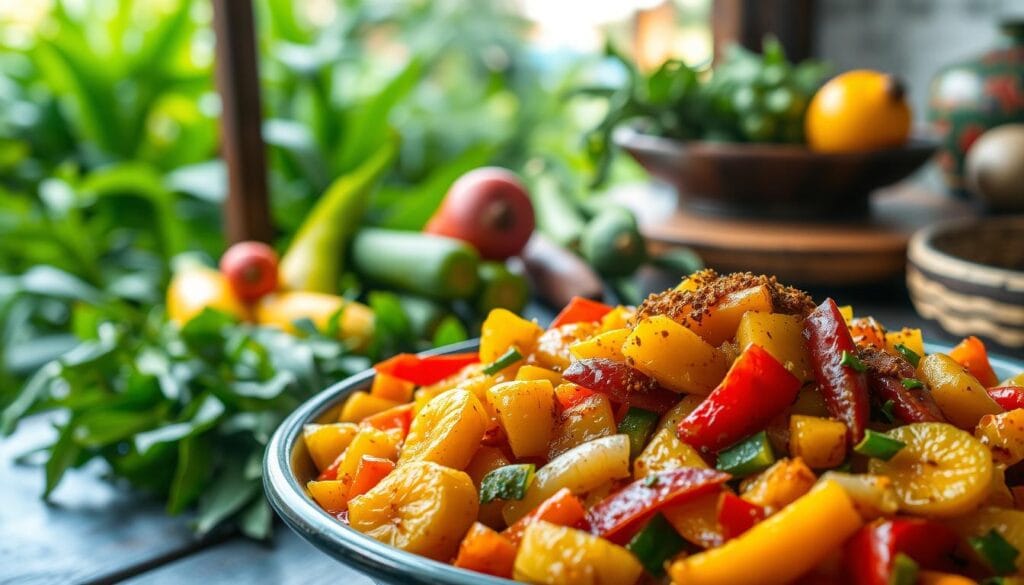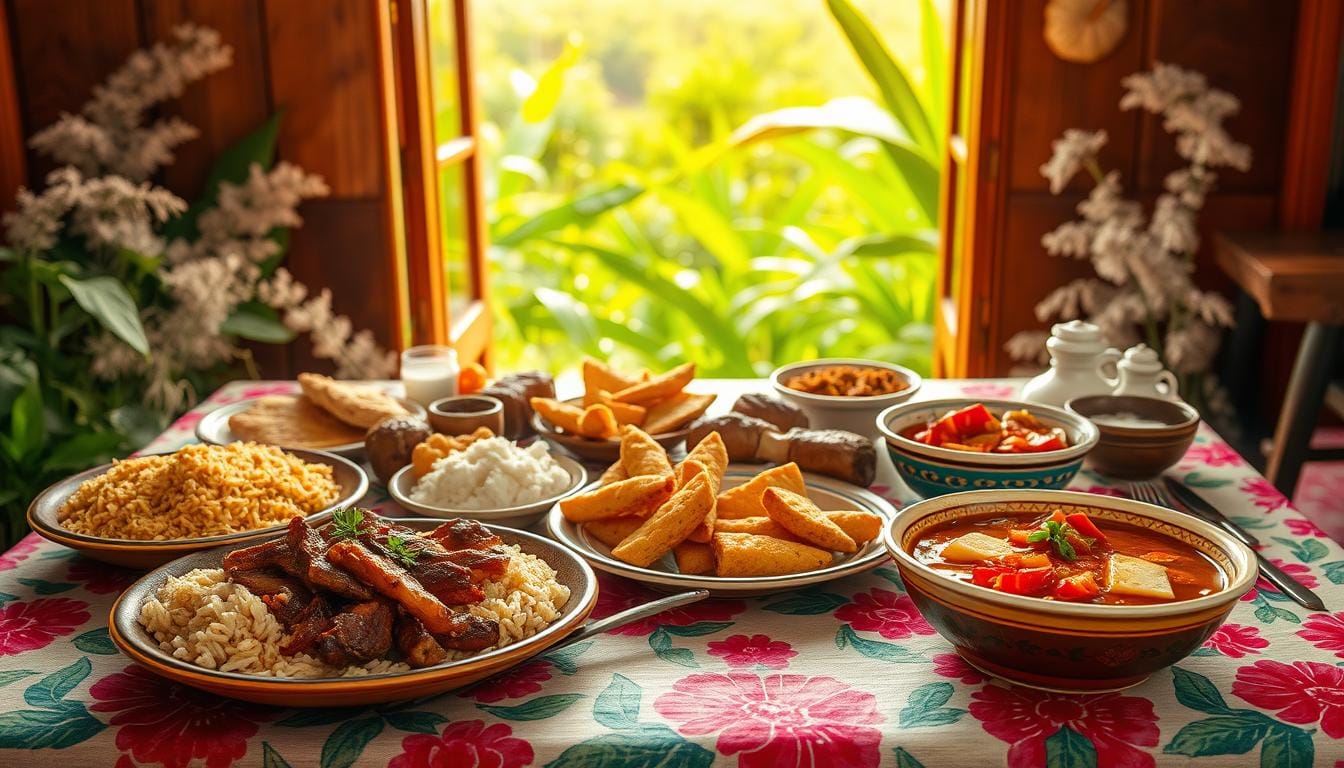Get ready to explore the rich flavors of Puerto Rican lunch recipes. You’ll learn how to make delicious, authentic dishes. Traditional Puerto Rican cuisine combines Spanish, African, and indigenous Taino influences. This mix creates a unique and savory taste.
Popular dishes like Arroz con Pollo and picadillo are known for their bold flavors. They use sofrito, a blend of sautéed onions, garlic, and bell peppers. Also, Medalla Light beer adds a special touch to these dishes. This article will help you try new flavors and learn to make traditional Puerto Rican cuisine.
Key Takeaways
- Discover the rich flavors of puerto rican lunch recipes and learn how to make delicious authentic puerto rican flavors.
- Traditional puerto rican cuisine is a fusion of Spanish, African, and indigenous Taino influences.
- Puerto rican lunch recipes are known for their bold flavors and hearty ingredients.
- Sofrito is a key ingredient in puerto rican cooking, adding flavor and depth to dishes.
- Medalla Light beer is a popular local beer used in many puerto rican recipes.
- Arroz con Pollo and picadillo are two popular puerto rican dishes that showcase the island’s culinary heritage.
Understanding Puerto Rican Cuisine: A Flavorful Journey
Puerto Rican cuisine is a mix of Spanish, African, and Taino influences. It offers a flavorful journey for your taste buds. The history of puerto rican cooking is rich and diverse, with each culture adding its own touch.
Key ingredients include plantains, yuca, beans, rice, pork, and chicken. These are used in dishes like mofongo, arroz con gandules, and pernil. Sofrito, a mix of sautéed onions, garlic, and more, is also crucial.
- Mofongo: made from fried green plantains, often with pernil or other meats
- Arroz con Gandules: a dish with rice and pigeon peas, flavored with sofrito and saffron
- Pernil: slow-roasted marinated pork shoulder, often served during holidays
Exploring the history of puerto rican cooking and trying these dishes is a flavorful journey through Puerto Rican cuisine.
Setting Up Your Puerto Rican Kitchen
To make an authentic Puerto Rican kitchen, you need the right tools and ingredients. You’ll want to have rice, beans, and sofrito on hand. These items are key for making traditional dishes.
Investing in a good food processor is smart. It’s great for making sofrito and sauces. You’ll also need a large pot and a rice cooker for cooking rice and beans.
Here are some must-haves to start:
- Rice and beans
- Sofrito
- Adobo seasoning
- Sazón
- Garlic and onions
With these ingredients and tools, you’re ready to cook delicious meals. Always use fresh ingredients. Don’t be afraid to try new flavors and spices to make your dishes unique.
Essential Puerto Rican Lunch Recipes for Beginners
When it comes to Puerto Rican lunch recipes, simplicity and flavor are key. As a beginner, you’ll want to start with dishes that are easy to make and delicious to eat. Puerto Rican lunch recipes often feature simple ingredients like rice, beans, and plantains, which are staples in the Puerto Rican diet.
Simple Rice and Beans Variations
Rice and beans are a classic combination in Puerto Rican cuisine. You can make a simple rice and beans dish by sautéing onions, garlic, and sofrito. Then, add in rice, beans, and chicken or beef broth. This is a great puerto rican lunch recipe for beginners because it’s easy to make and requires minimal ingredients.
Quick Tostones Recipe
Tostones are a popular Puerto Rican side dish made from fried green plantains. To make tostones, simply slice the plantains into rounds, fry them in oil until crispy, and serve with a side of garlic sauce. This is a great beginner recipe because it’s quick and easy to make.
Basic Sofrito Preparation
Sofrito is a staple ingredient in Puerto Rican cooking, and it’s easy to make at home. Simply chop up some onions, garlic, and cilantro, and sauté them in oil until they’re soft and fragrant. You can use sofrito as a base for many different puerto rican lunch recipes, including rice and beans, tostones, and more.
Some popular puerto rican lunch recipes for beginners include arroz con gandules, which is a hearty rice and bean dish, and mamposteao, which is a simple rice and bean dish made with sofrito and garlic. These dishes are all easy to make and require minimal ingredients, making them perfect for beginners.
| Recipe | Ingredients | Instructions |
|---|---|---|
| Arroz con Gandules | Rice, beans, chicken broth, sofrito | Sauté sofrito, add rice and beans, cook until tender |
| Mamposteao | Rice, beans, sofrito, garlic | Sauté garlic and sofrito, add rice and beans, cook until tender |
Authentic Arroz con Gandules: The National Dish
Exploring puerto rican cuisine leads to arroz con gandules, the national dish. It’s a key part of Puerto Rican celebrations, feeding many with ease. To make it, you’ll need rice, pigeon peas, and sofrito, key to puerto rican cuisine.
Arroz con gandules has 610 calories, with 96 grams of carbs. It’s also rich in protein and fiber, making it nutritious and satisfying. To cook it, use a caldero with sofrito, tomato sauce, and spices.
Cooking arroz con gandules takes 27-30 minutes on low heat. It serves 6 people. You’ll need 2 cups of Jasmine rice, 3 cups of water or chicken stock, 7 oz of pigeon peas, 1/4 cup of sofrito, and 1/4 cup of tomato sauce for the authentic taste.
Mastering Mofongo: Tips and Techniques
To make delicious mofongo, knowing the traditional methods is key. Mofongo uses mashed plantains. The right plantains, green and firm, are crucial for the best taste.
Traditional mofongo involves mashing fried plantains with garlic and salt. Then, it’s served with seafood, chicken, or beef. Using a mortar and pestle helps achieve a smooth, creamy texture.
Some like to add pork cracklings or bacon to the mash. Others prefer boiled plantains for a softer texture. These variations can make your mofongo stand out.
Here are some key tips for making mofongo:
- Choose the right plantains: Green and firm plantains are best for mofongo.
- Use traditional methods: Mashing fried plantains with garlic and salt is the traditional way to make mofongo.
- Experiment with variations: Try adding different ingredients or accompaniments to create unique mofongo dishes.
Mastering mofongo lets you enjoy this traditional Puerto Rican dish at home. With these tips, you’ll make authentic and delicious mofongo that will be a favorite in your household.
Puerto Rican Lunch Recipes for Special Occasions
Puerto Rican lunch recipes are perfect for adding flavor and culture to any celebration. They’re great for holiday parties or just a delicious meal with family. You can choose from classics like Arroz con Pollo to seafood paella.
For special occasions, consider making extra dishes to go with your main course. Roasted pork, stewed chicken, and vegetable dishes are popular choices. Don’t forget traditional sides like tostones or maduros to complete your meal.
Here are a few tips for making delicious puerto rican lunch recipes for special occasions:
- Use fresh and high-quality ingredients for the best flavor.
- Don’t be afraid to try new recipes and ingredients.
- Make a few dishes ahead of time to save time and stress.
With these tips and a bit of practice, you’ll master making delicious puerto rican lunch recipes for special occasions. They’re perfect for any celebration or just a tasty meal. So, why not try them and add some Puerto Rican flavor to your next special occasion?
Hearty Meat-Based Puerto Rican Dishes
Puerto Rican food is famous for its bold flavors and hearty dishes. Meat-based dishes are a big part of this. Pernil, a slow-roasted pork shoulder, is a favorite. It’s marinated in spices, herbs, and citrus juice.
Other popular dishes include:
- Bistec Encebollado, a steak and onion dish cooked in a savory broth
- Pollo Guisado, a stewed chicken with vegetables and spices
These dishes are great for special events or everyday meals. They pair well with rice, beans, and veggies. Their rich flavors and tender textures make them a staple in Puerto Rican cuisine.
Looking for something classic or adventurous? Puerto Rican meat dishes have it all. Try one of these hearty recipes and taste the bold flavors and rich traditions of Puerto Rico.
| Dish | Ingredients | Cooking Time |
|---|---|---|
| Pernil | Pork shoulder, spices, herbs, citrus juice | 2-3 hours |
| Bistec Encebollado | Steak, onions, broth, spices | 30-40 minutes |
| Pollo Guisado | Chicken, vegetables, spices, broth | 45-60 minutes |
Seafood Specialties from the Island
Puerto Rico is famous for its fresh puerto rican seafood. This seafood is a key part of many traditional dishes. The island’s long coastline offers a wide variety of seafood, making it a big part of local food.
Some top island specialties include Arroz con Camarones and Bacalaítos. Arroz con Camarones is a tasty rice dish with shrimp. Bacalaítos are crispy fritters from salted codfish.
Here are some recipes to try:
- Arroz con Camarones: a quick recipe that takes 30 minutes. It needs 4 teaspoons of achiote oil, ½ cup of sofrito, and 1 pound of deveined shrimp.
- Bacalaítos: a favorite street food from salted codfish, flour, and water. It’s often served with tostones or fried plantains.
- Alcapurrias: a fried snack from green plantains and yautía. It’s filled with picadillo or seafood.
These puerto rican seafood dishes are not just tasty. They also highlight the island’s rich food culture. With plenty of fresh seafood and traditional recipes, you can make your own island specialties. Enjoy the flavors of Puerto Rico in your own kitchen.
Vegetarian Puerto Rican Lunch Options
Exploring Puerto Rican cuisine reveals a world of tasty vegetarian dishes. You’ll find everything from plant-based alternatives to traditional vegetable dishes. This section dives into the puerto rican vegetarian world, showcasing its unique flavors and ingredients.
Puerto Rican vegetarian food focuses on plant-based alternatives. It uses fresh veggies, fruits, and whole grains for healthy, tasty meals. You can enjoy vegan versions of mofongo and arroz con gandules. Also, try traditional vegetable dishes like tostones and fried plantains.
Here are some tips for making delicious Puerto Rican vegetarian dishes:
- Use a variety of spices and seasonings to add flavor to your dishes
- Experiment with different types of vegetables, such as yuca, batata, and yautia
- Try using plant-based alternatives to traditional ingredients, such as vegan mayo and ketchup

In conclusion, Puerto Rican vegetarian cuisine is full of tasty, authentic options for plant-based eaters. It highlights fresh ingredients, bold flavors, and creative takes on traditional dishes. So, why not try it out and explore the puerto rican vegetarian world?
| Dish | Ingredients | Prep Time |
|---|---|---|
| Tostones | Green plantains, garlic, olive oil | 20 minutes |
| Mofongo | Fried green plantains, garlic, olive oil | 30 minutes |
| Arroz con Gandules | Rice, pigeon peas, olive oil, garlic | 40 minutes |
Quick and Easy Puerto Rican Sandwiches
Puerto Rican sandwiches mix flavors and textures in a way that’s irresistible. To make quick and easy ones, start with a basic recipe and add your own flair. The sandwich de mezcla, a mid-20th century gem, is a great place to begin.
To craft a tasty puerto rican sandwich, you’ll need a few key items. These include fresh bread, juicy meats, and crunchy veggies. Here’s how to get started:
- Use a mix of olive oil and spices to flavor your sandwich
- Choose a variety of fresh herbs, like cilantro and scallions, for freshness and depth
- Feel free to try different meats and cheeses to find your favorite mix
With these tips and a bit of practice, you can whip up your own quick and easy puerto rican sandwiches. Whether you’re craving a classic sandwich de mezcla or something bold, the options are endless. So, why not start today and explore the tasty realm of puerto rican sandwiches?
Side Dishes That Complete Your Puerto Rican Lunch
There are many tasty puerto rican side dishes to pick from. Classics like rice and beans, or tostones with mojo sauce, are favorites. But, new dishes mix old flavors with global tastes.
Mofongo is a hit, made from mashed plantains filled with meat or seafood. Arroz con gandules is another favorite, a rice dish with pigeon peas and pork. You might also enjoy yuca con mojo, crispy cassava root with garlic sauce, or ensalada de papa, a potato salad with onions and a tangy dressing.
Modern twists have also entered the scene. Pastelón layers sweet plantains, meat, and cheese. Alcapurrias are crispy balls filled with green bananas and taro root. These dishes show Puerto Rico’s culinary creativity.
Looking for something traditional or a modern twist? Puerto Rican cuisine has it all. Its rich flavors and varied ingredients will surely impress you.
Making Puerto Rican Drinks and Beverages
Puerto Rico is famous for its tasty and cool puerto rican drinks, like coffee and juice. We’ll look at some classic beverages and share drink recipes for you to try at home.
Coquito is a beloved puerto rican drink. It’s creamy, sweet, and made with coconut milk, sweetened condensed milk, and rum. To make it, you need 14 oz of sweetened condensed milk, 12 oz of evaporated milk, 13.5 oz of unsweetened coconut milk, and 2 1/2 cups of light rum. You can add vanilla or cinnamon for a special flavor.
Piña Colada is another refreshing beverage. It’s a classic cocktail with pineapple, coconut cream, and rum. You’ll need 1/2 cup of pineapple chunks, 1/4 cup of coconut cream, and 2 oz of rum. A splash of grenadine adds a fruity twist.

These drink recipes are great for hot summer days or parties. You can try different flavors to make your own puerto rican drinks. With these recipes, you can enjoy Puerto Rico’s flavors right at home.
Time-Saving Tips for Puerto Rican Cooking
Puerto Rican cooking can take a lot of time. But, with smart strategies, you can save hours. Meal prep is a great way to do this. It lets you prepare ingredients ahead of time, making your dishes quicker to cook.
For example, making a batch of sofrito ahead of time is a good idea. This is a key ingredient in Puerto Rican cooking. You can keep it in the fridge or freezer for later use.
Using dehydrated sofrito is another smart move. It has the same great flavors as fresh sofrito but doesn’t need to be refrigerated. Grating vegetables with a food processor also saves time, especially for dishes like pasteles de masa. Freezing pasteles before cooking is handy, especially during busy times like holidays.
Here are some more tips to save time in Puerto Rican cooking:
- Prepare ingredients like chopping onions and garlic ahead of time.
- Use pre-cooked meats, like pernil, to cut down on cooking time.
- Get dishes ready in advance, like making empanada fillings.
By using these tips, you can enjoy tasty Puerto Rican dishes without spending all day cooking. A bit of planning and prep work can make meal prep easy. This way, you can enjoy the flavors of Puerto Rico any time of the year.
Common Mistakes to Avoid in Puerto Rican Cooking
When cooking Puerto Rican dishes, it’s easy to make mistakes. One big one is not using enough sofrito. Sofrito is a mix of culantro, onions, garlic, and ajíes dulces. It’s key to the taste of Puerto Rican food.
Another mistake is using the wrong ingredients. For example, frozen seafood can change the flavor and texture of a dish. Most Puerto Rican homes prefer fresh seafood. Also, the right rice and the right water ratio are important. The usual ratio for rice to water is 1:1.
Here are some tips for cooking Puerto Rican dishes:
- Use fresh ingredients whenever possible
- Don’t overcook the rice or seafood
- Use the right type of sofrito and sazon
- Plan ahead and thaw seafood in advance
By avoiding these mistakes and following these tips, you can make delicious Puerto Rican dishes. Always use fresh ingredients and cook with love. Don’t be afraid to try new things. With practice, you’ll get better at cooking Puerto Rican food.
| Ingredient | Quantity |
|---|---|
| Culantro | 1/2 pound |
| Onions | 3 large |
| Garlic | 25 cloves |
| Ají dulce peppers | 1 pound |
Conclusion: Embracing the Joy of Puerto Rican Cooking
Puerto Rican cooking is a vibrant mix of flavors and cultures. It includes dishes like arroz con gandules and mofongo. Each dish tells a story of Puerto Rico’s rich history and heritage.
By trying out Puerto Rican cooking, you can taste the island’s tropical paradise. It’s all about the delicious flavors and aromas.
Mastering Puerto Rican cuisine means knowing the key ingredients and techniques. This guide has recipes and tips to help you. So, don’t hesitate to try new things and explore the culinary wonders of Puerto Rico.
Whether you’re planning a Puerto Rican-themed party or just want to try something new, let Puerto Rican cooking guide you. Enjoy the smells, tastes, and colors of this cuisine. Share your dishes with loved ones. Buen provecho!
FAQ
What is the history and cultural significance of Puerto Rican cuisine?
What are the key ingredients and cooking techniques used in Puerto Rican cooking?
What are the essential tools and ingredients needed to set up a Puerto Rican kitchen?
What are some simple and delicious Puerto Rican lunch recipes for beginners?
How do I make the national dish of Puerto Rico, Arroz con Gandules?
What are the key tips and techniques for making authentic Mofongo?
What are some Puerto Rican lunch recipes that are perfect for special occasions?
What are some delicious and authentic Puerto Rican seafood recipes?
What are some vegetarian and plant-based Puerto Rican lunch options?
What are some quick and easy Puerto Rican sandwich recipes?
What are some traditional Puerto Rican side dishes and accompaniments?
How can I make delicious Puerto Rican drinks and beverages?
What are some time-saving tips for preparing Puerto Rican cuisine?
What are some common mistakes to avoid when cooking Puerto Rican dishes?
Table of Contents
Did you like this recipe?
There are no reviews yet. Be the first one to write one.

